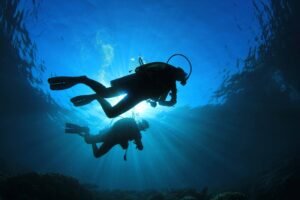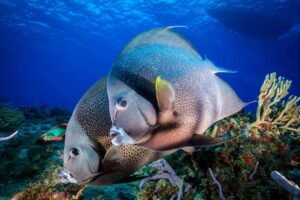Welcome, fellow diving enthusiasts! Whether you’re an experienced diver or just dipping your toes into the underwater world, understanding the language of scuba diving is essential for a safe and enjoyable experience. Welcome to the ABCs of Diving, where we will explore different scuba diving terms as we go through the alphabet. To read previous posts from this column check out our other blogs. Today we continue with the letter R:
Rash Guard: A rash guard is a tight-fitting shirt made from synthetic fabrics designed to protect the skin from rashes caused by sun exposure, coral, and other irritants while diving or snorkelling. These garments provide UV protection and are often worn under wetsuits for added comfort.

Rebreather: A rebreather is a specialized piece of diving equipment that allows divers to recycle their exhaled air, removing carbon dioxide and adding oxygen back into the system. This technology enables longer dives without the need for large tanks, minimizes bubble production, and reduces the risk of decompression sickness.
Recompression: Recompression refers to the process of returning a diver suffering from decompression sickness to a high-pressure environment, usually inside a hyperbaric chamber. This treatment helps to dissolve nitrogen bubbles formed in the body during a dive, alleviating symptoms and promoting recovery.
Recreational Dive Planner (RDP): The Recreational Dive Planner (RDP) is a tool used by divers to calculate no-decompression limits, allowing them to plan their dives safely. The RDP helps divers understand their limits and manage surface intervals to minimize the risk of decompression sickness.
Recreational Scuba Diving: Recreational scuba diving is diving for enjoyment rather than for professional or commercial purposes. This activity includes exploring underwater environments, observing marine life, and enjoying the beauty of the ocean while adhering to safety standards and dive planning.
Reel: A reel is a device used by divers to manage line and mark their path, especially in cave diving or wreck diving scenarios. Reels help divers navigate back to their entry point and can be critical for safety in low-visibility environments.
Regulator: A regulator is a vital piece of scuba equipment that controls the flow of air from the tank to the diver. It reduces the high pressure of the air in the tank to a breathable level and allows the diver to inhale air comfortably while underwater.
Repetitive Dive: A repetitive dive occurs when a diver makes multiple dives within a short period, typically on the same day. Understanding the effects of repetitive dives is crucial for managing nitrogen absorption and ensuring safe ascent practices to avoid decompression sickness.
Reserve Gas: Reserve gas refers to the air supply that a diver keeps in their tank as a safety measure. It’s recommended to reserve a certain amount of gas for emergencies, allowing the diver to ascend safely even if they encounter unexpected issues during a dive.
Reverse Squeeze: A reverse squeeze is a condition that occurs when a diver ascends too quickly, causing air trapped in body cavities (like the sinuses or ears) to expand. This can lead to pain or injury if not equalized properly. It’s essential for divers to ascend slowly and perform equalization techniques to avoid this issue.
Rip Current: A rip current is a powerful, narrow channel of water that flows away from the shore. It can be dangerous for divers and swimmers, as it can pull them away from the beach quickly. Knowing how to identify and escape rip currents is critical for safety in ocean conditions.
Scuba diving is a blend of technical skill, environmental awareness, and appreciation for marine life. By familiarizing yourself with these diving terms, you’ll enhance your diving knowledge and safety practices, ensuring each underwater adventure is a memorable and enjoyable experience. Whether you’re exploring reefs, wrecks, or underwater caves, the underwater world awaits with its mysteries and beauty. Happy diving!


